Physical Address
304 North Cardinal St.
Dorchester Center, MA 02124
Physical Address
304 North Cardinal St.
Dorchester Center, MA 02124
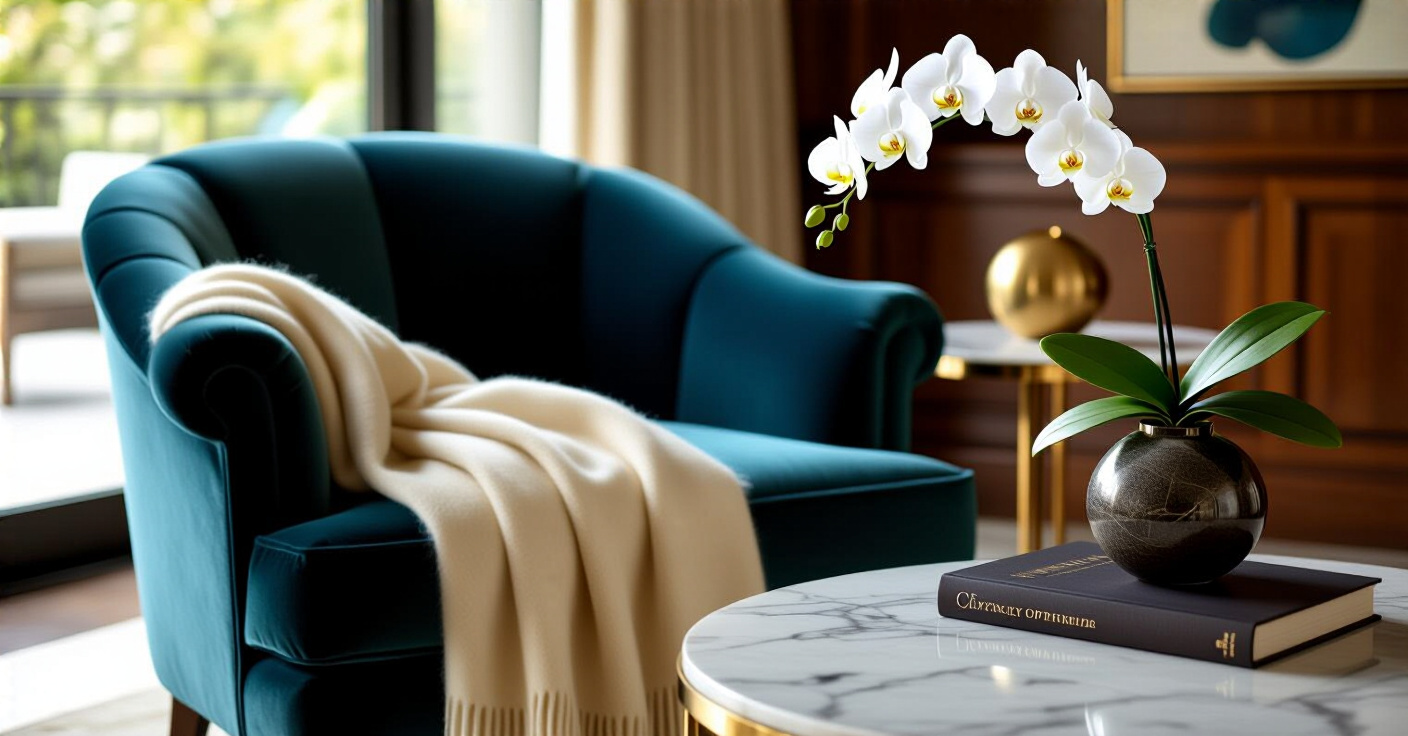
Discover 20 timeless principles for crafting an authentic luxurious living room in a historic home, blending preservation with modern functionality and style.
Picture this: You’re standing in the living room of a 1910 Craftsman home. The air smells of old wood and history. You see the deep, original gumwood trim, the sturdy fieldstone fireplace, and the wavy glass in the windows. Now, picture a sterile, all-white room with generic furniture dropped inside. It feels wrong, doesn’t it? A space like that isn’t just an empty box; it’s a vessel of stories, built with hands and heart.
Creating a truly luxurious space in a historic home is an act of conversation, not conquest—every choice reflects not just your personal taste, but a deep respect for the home’s original narrative. The most compelling rooms aren’t decorated; they are thoughtfully curated to honor the past while embracing the present. They tell coherent stories about their history and their inhabitants. These 20 principles separate an authentically luxurious living room from one that simply looks expensive.
Before you even think about a paint chip or a fabric swatch, you have to understand the bones of your room. This first phase is about listening to the space—its proportions, its light, and its history. This isn’t just floor planning; it’s about making a pact with the house to honor its character while making it work for your life today.
People get so hung up on a specific “style”—like Mid-Century Modern or Art Deco—that they try to force it onto a house where it doesn’t belong. A Federal-style home will never be a convincing minimalist loft, and that’s okay. True style isn’t about imposing a trend; it’s about discovering the house’s inherent character and weaving your own story into it. This is your blueprint, your North Star for every decision that follows. It saves you from costly mistakes and creates a space that feels deeply, authentically yours.
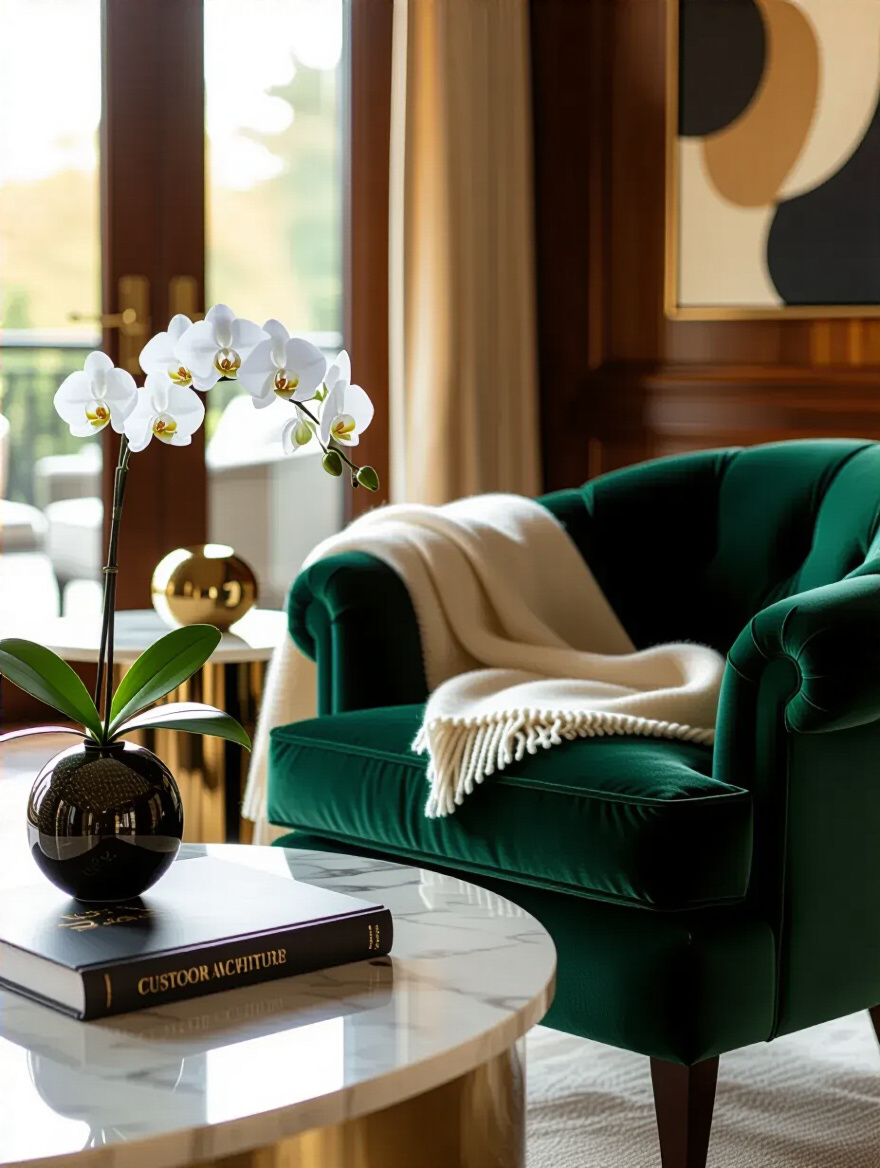
I once worked with a client in a beautiful Georgian Revival. She loved Scandinavian design and was about to paint all the elaborate mahogany paneling white. I gently talked her down. We found a middle ground: we kept the rich wood but brought in clean-lined furniture, handwoven wool textiles, and a simple, warm color palette drawn from historic precedents. The result wasn’t purely Georgian or purely Scandi; it was a unique conversation between the two. That’s what a real aesthetic blueprint does—it builds bridges, it doesn’t burn them.
From here, everything else starts to fall into place, because you’re no longer just picking things you like; you’re choosing pieces that belong to the same story.
You know what people always ask me? “How do I make my old house feel less boxy?” They think the answer is to knock down walls. More often than not, the answer is just smarter furniture placement. Historic homes were designed with intentional procession—from a formal entry, to the living room, to the dining room. Understanding this original flow is the key to making a room feel both grand and comfortable, not like an obstacle course.
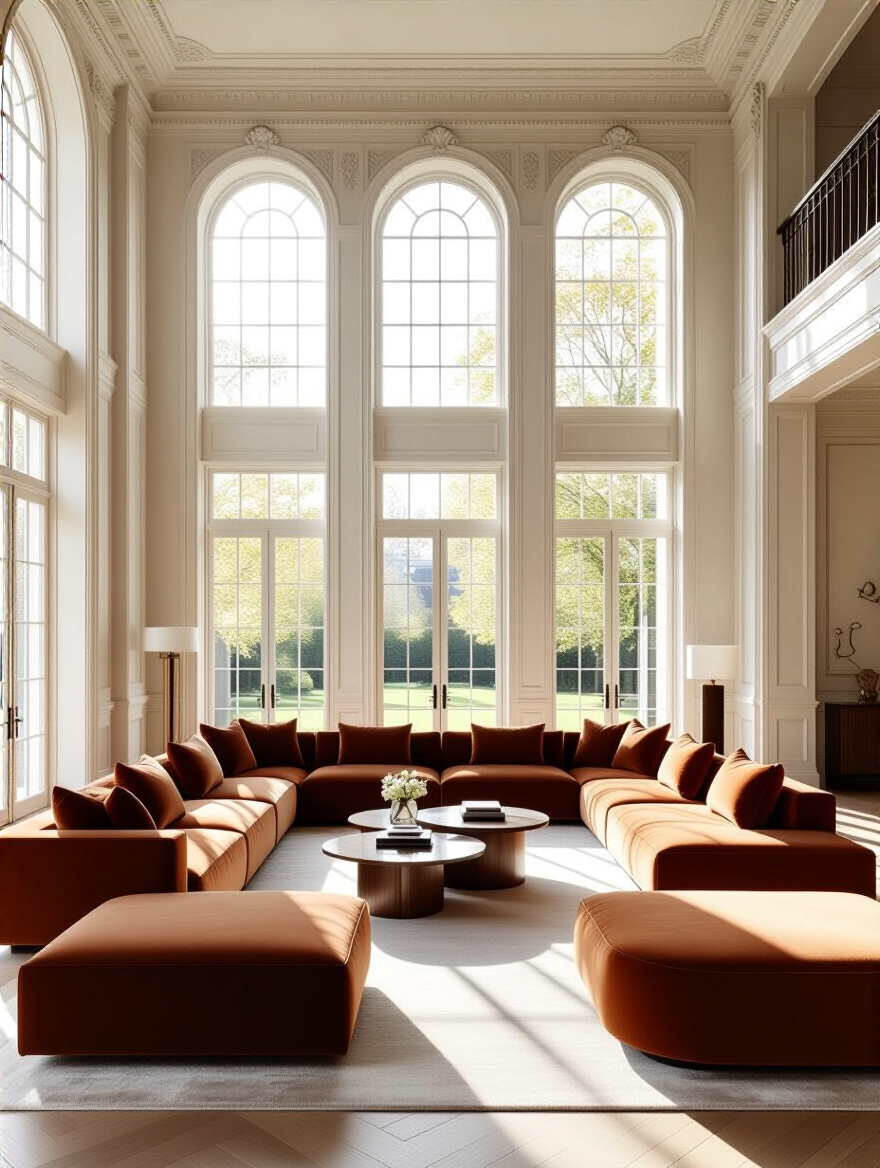
The goal is to create intuitive pathways and cozy conversation zones without fighting the room’s architecture. Stop pushing all your furniture against the walls! It’s a classic mistake that creates a strange, empty void in the middle—a “dead zone.” Instead, try floating a sofa off the wall, creating a path behind it. Arrange chairs in conversational groups. This respects the room’s formal proportions while making it feel inviting and functional for modern life. It makes the space feel larger and more intentional.
This foundational step ensures your beautiful room is also a joy to live in, setting the stage for the colors and light that will bring it to life.
Can we talk about why everyone defaults to painting old houses stark white? It’s a pet peeve of mine. Historic interiors were rarely white; they were filled with rich, complex colors that played with the limited natural and gaslight of the era. These deeper hues—ochres, mossy greens, dusty blues, deep reds—create an incredible sense of depth and intimacy. They make architectural details like plaster molding and carved woodwork pop in a way that white paint simply flattens.
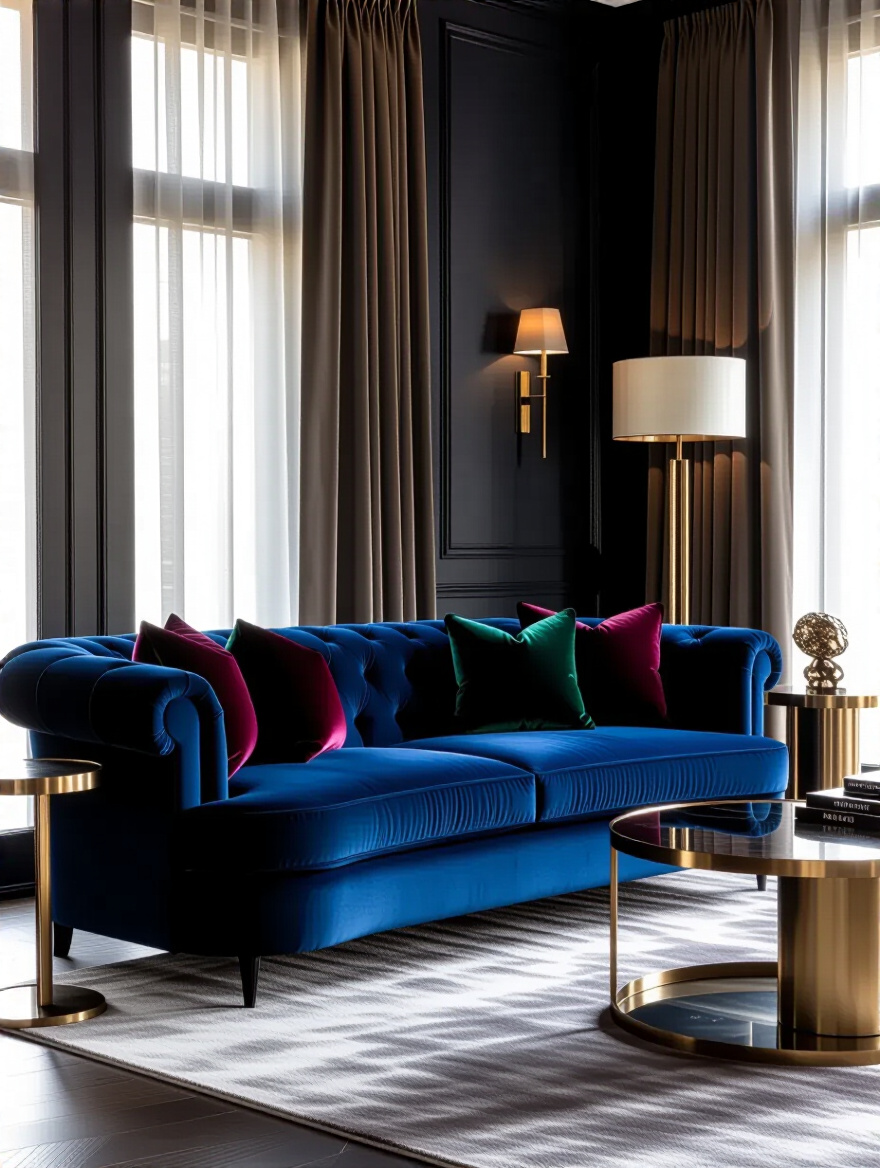
Choosing a palette isn’t about picking trendy colors. It’s about looking to the home’s history for clues and understanding how light works in your specific room. Find a dominant, rich color that speaks to the home’s era, then layer in complementary tones. Use lighter shades on the ceiling to create a sense of height. I worked on a Victorian home where we used a deep, moody teal on the walls. It sounds dramatic, but with the tall ceilings and large windows, it felt enveloping and incredibly sophisticated, like stepping into a jewelry box.
With your palette established, the next layer of magic comes from how you illuminate it.
I used to think lighting was just about function. Then I spent a week in an 18th-century house in Charleston lit almost entirely by candlelight and period-style lamps. The glow was transformative. It proved to me that lighting is the single most powerful tool for creating mood. Relying on a single, harsh overhead light—what I call the “interrogation light”—is the fastest way to kill the soul of a room.
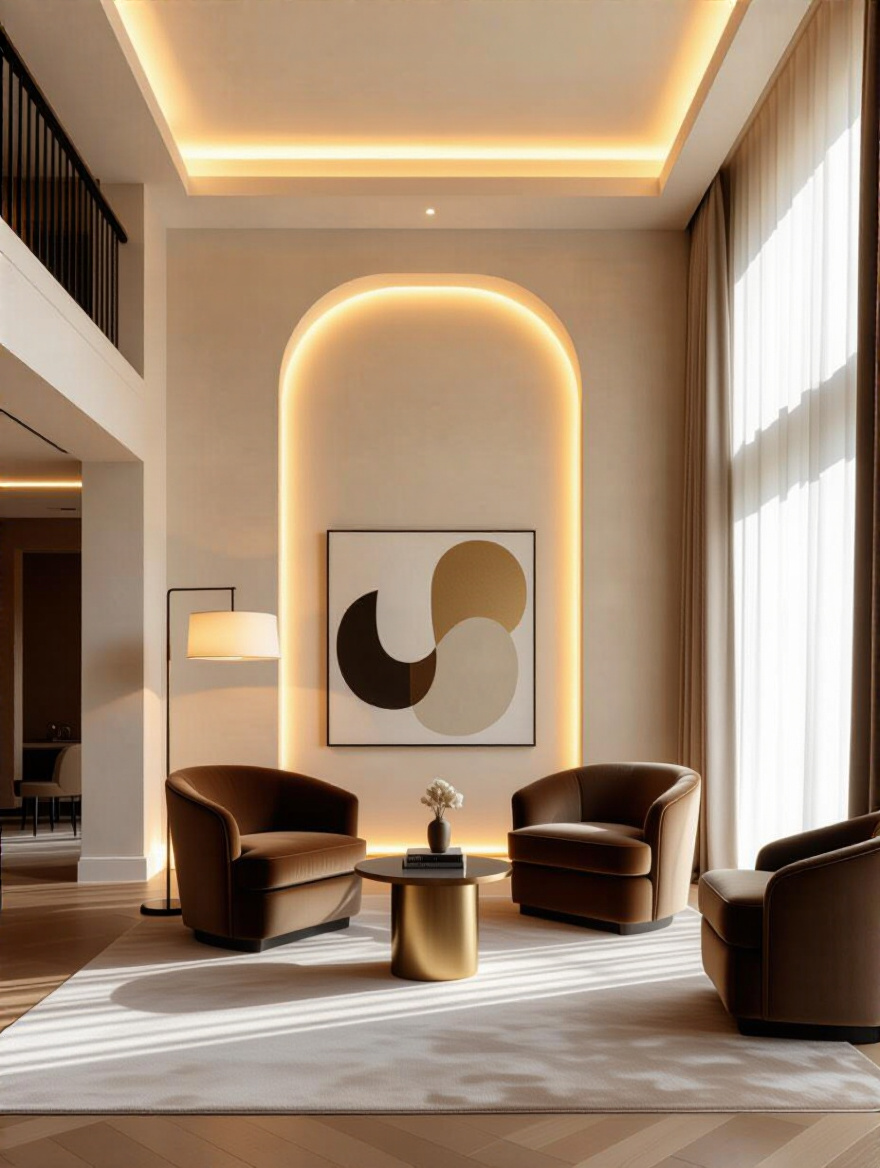
A luxurious, historic space needs layers. First, you need ambient light, a soft, general glow from things like a beautiful central fixture or wall sconces that wash the walls with light. Then, add task lighting—elegant floor lamps for reading, a small lamp on a side table. Finally, the crucial layer: accent lighting. This is where you use small spotlights or picture lights to highlight artwork, architectural details, or the texture of a stone fireplace. Using dimmers on everything is non-negotiable. It allows you to tailor the atmosphere from bright and lively to soft and intimate.
Now that we have the room’s structure, color, and light in harmony, we can start to furnish it with intent.
This is where we begin to place the key players on our stage. We’ve set the scene, and now it’s time to introduce the foundational pieces that will anchor the entire design. Think of these as the main characters in your living room’s story.
Everyone says you have to spend a fortune to get a luxurious look. They’re wrong. True luxury is about strategic investment, not indiscriminate spending. It’s about knowing where to splurge and where to save. The noise tells you to buy a whole matching set of expensive furniture. The reality is you should invest the lion’s share of your budget on the pieces that get the most use and have the biggest visual impact.
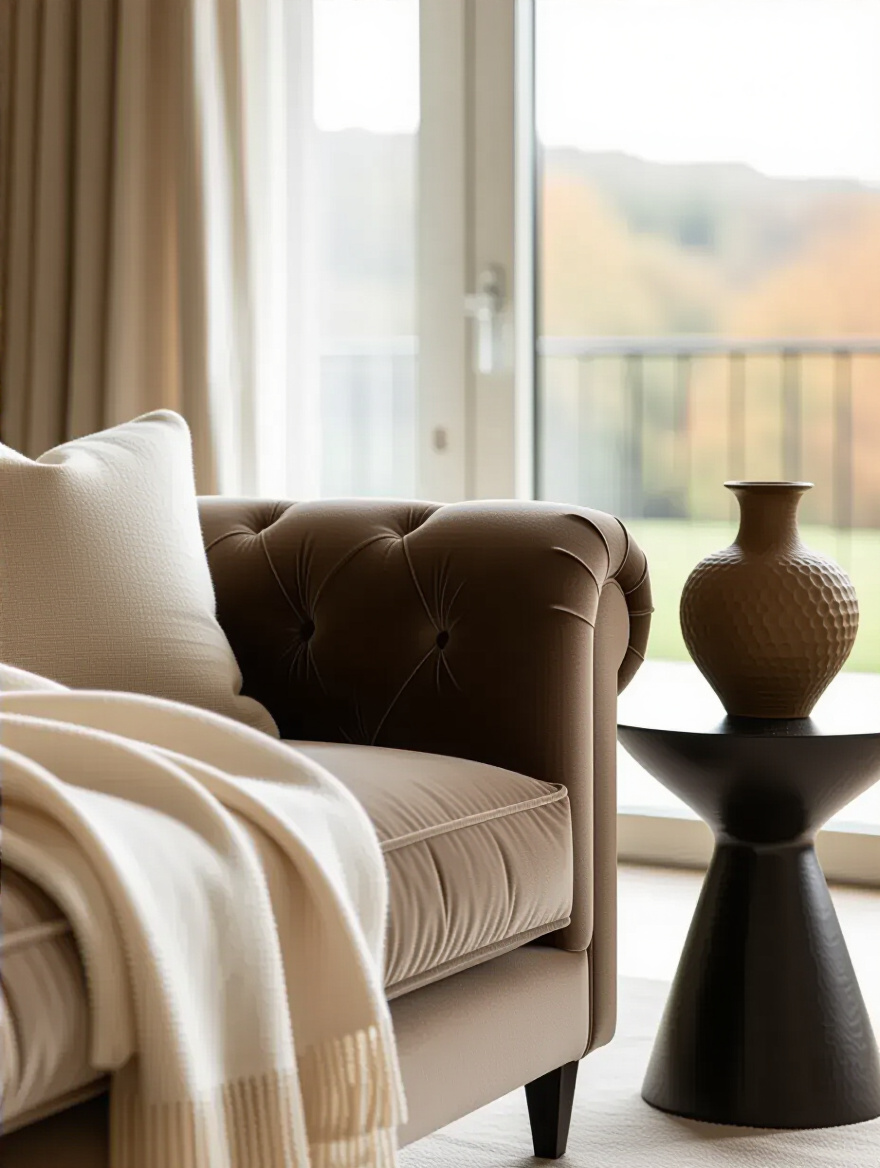
This means spending money on a superbly crafted sofa, a hand-knotted wool rug that will last a century, or custom window treatments. These are the workhorses of the room. You can find a beautiful vintage side table or a unique lamp at an antique market for a fraction of the cost of a designer piece. I learned this the hard way on one of my first projects, where I blew half the budget on trendy accessories that were dated in two years, leaving little for the sofa that had to be replaced in five. Invest in timeless quality for the core pieces, and your room will always feel substantial and elegant.
The most important of these core pieces, without a doubt, is the one you’ll spend the most time on.
Your sofa is the undisputed anchor of your living room. It’s not just a place to sit; it’s a piece of sculpture, a comfort machine, and the single biggest furniture decision you’ll make. Getting it wrong throws the whole room off balance. People often get seduced by a trendy shape and forget to actually sit in it, or they buy something too massive or too tiny for the scale of a historic room.
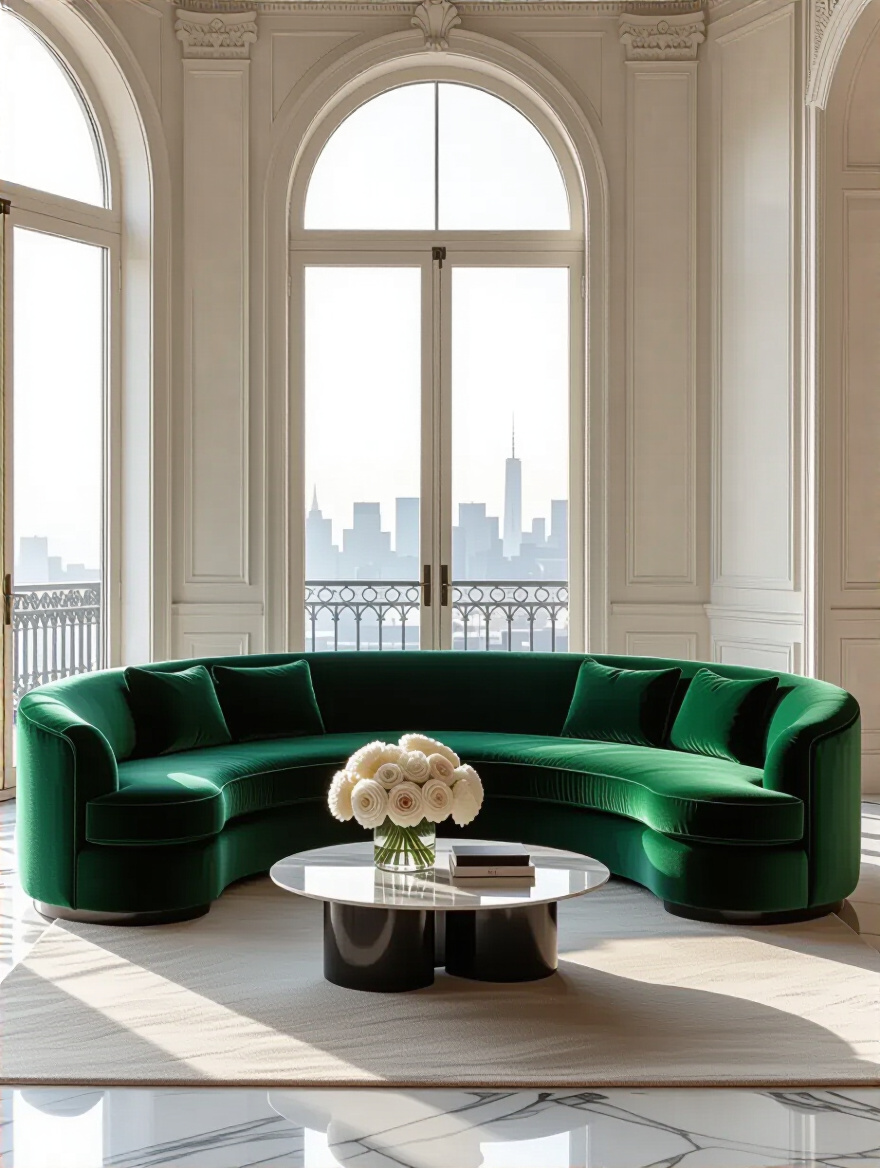
Forget trends. Look for classic, enduring forms like an English roll arm or a Chesterfield, but don’t be afraid of a clean-lined modern piece if its proportions are right. The real luxury is in what you can’t see: the frame. Insist on a kiln-dried hardwood frame with eight-way hand-tied springs. It’s the difference between a sofa that lasts five years and one that lasts fifty. Then, invest in beautiful, durable upholstery—a rich velvet, a sturdy linen, or high-quality leather that will develop a beautiful patina over time.
Once the sofa has claimed its spot, you need something just as foundational to ground it.
I’ve noticed something weird about how people use rugs lately: they treat them like postage stamps. A small rug floating in the middle of a room makes everything feel disconnected and cheapens the space. A proper area rug is the foundation that ties an entire seating area together. It’s the visual and textural anchor that defines the space and adds a critical layer of warmth and sound absorption, especially on old hardwood floors.
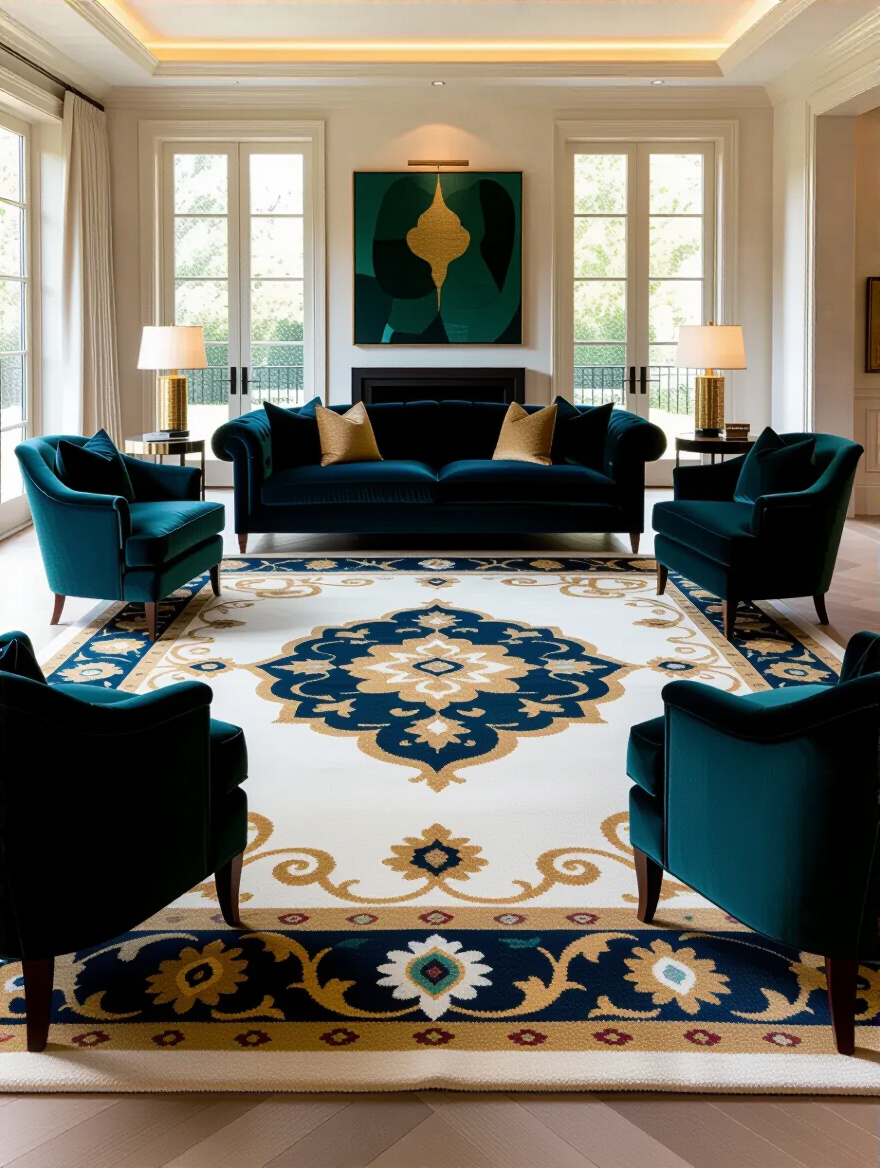
The rule is simple: the rug needs to be large enough for at least the front legs of your sofa and all accent chairs to sit on it. This creates a unified, cohesive zone. In terms of material, nothing beats the durability and feel of hand-knotted wool. A good vintage Persian or Turkish rug already has a story and soul, and it will outlive all of us. Don’t be afraid of pattern and color here; a rug is a perfect place to introduce a dose of personality that pulls the whole room together.
With the core foundations in place, we can turn our attention to the architectural elements that give the room its true character.
Now we move from the things you put in a room to the things that are part of the room. These are the details that separate a beautifully decorated space from one with deep, architectural soul. This is where a historic home truly shines.
The quickest way to make a historic room feel cluttered is to fill it with bulky, freestanding furniture that doesn’t fit the space. Bespoke built-ins are the antidote. They feel like part of the original architecture, creating seamless storage and display that honors the room’s proportions. Think of elegant library shelves flanking a fireplace or a graceful window seat built into a bay window.
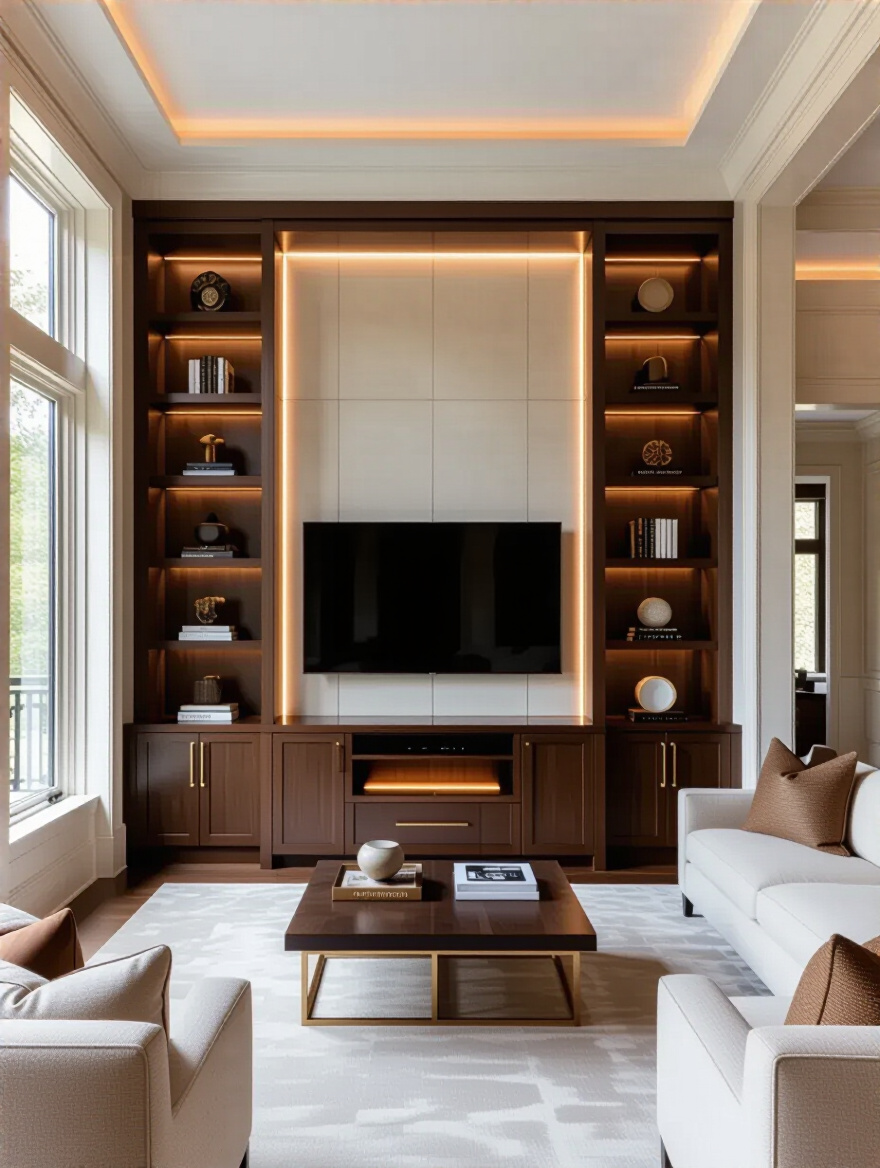
This isn’t about just hiding your clutter; it’s about creating architectural grace. I worked on a project where we replicated the home’s original molding profiles for a new floor-to-ceiling bookcase. It looked like it had always been there, providing incredible function without compromising an inch of the room’s historic integrity. Done thoughtfully, built-ins add more character and value to your home than almost any piece of furniture you could buy.
These custom pieces are a testament to craftsmanship, just like the home’s original surfaces.
In a historic home, the floors and walls are your most important assets. Please, I beg you, don’t be so quick to rip out original hardwood or cover up beautiful plaster with drywall. These surfaces have a patina and quality that you simply can’t replicate. Luxury here isn’t about what’s newest and shiniest; it’s about preserving and celebrating authenticity.
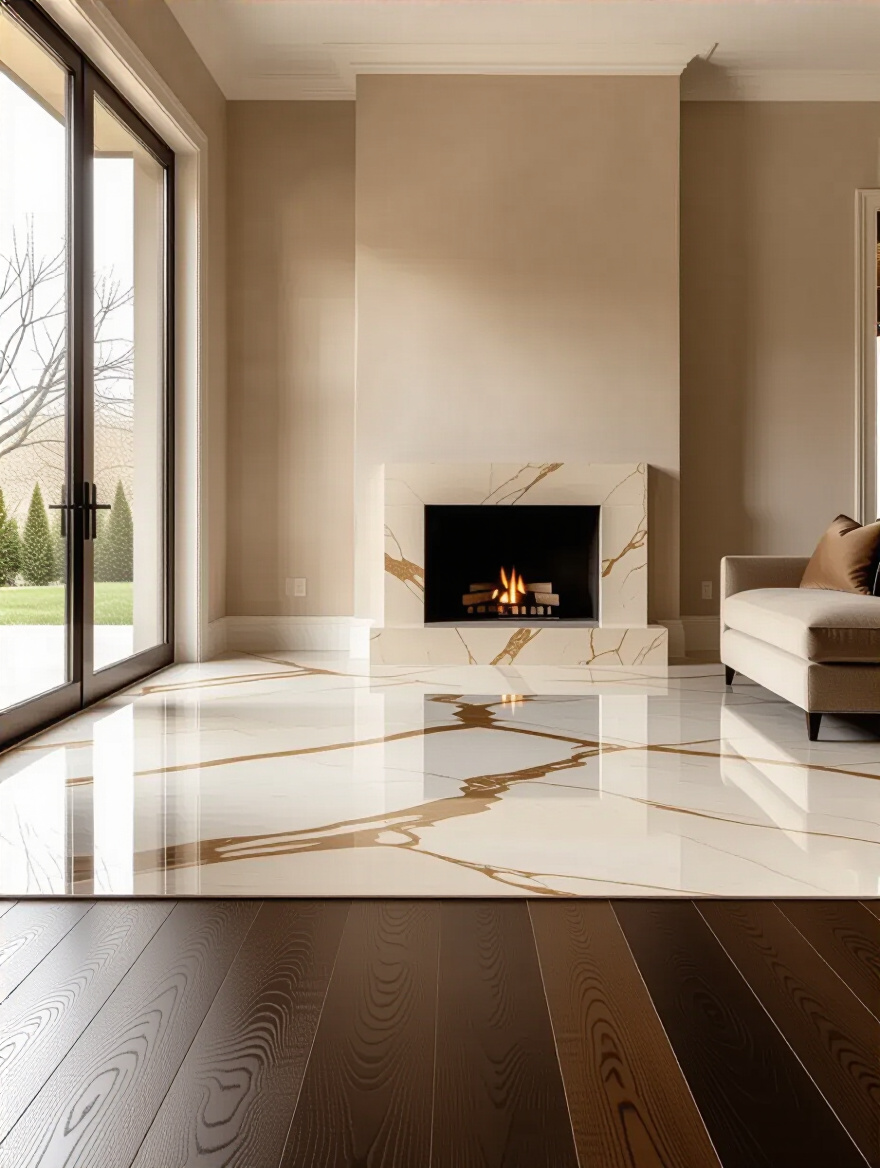
Refinishing original wood floors to bring out their deep, warm tones is almost always the best choice. For walls, consider treatments that add texture and depth, like a traditional lime wash, grasscloth wallpaper, or even restoring the original plaster. These finishes interact with light in a way that flat paint never can, creating a soft, luminous quality. It’s about choosing materials that are honest, durable, and sympathetic to the house’s age and style.
These surfaces provide the perfect canvas for the architectural “jewelry” of the room.
Crown molding, wainscoting, and a beautiful fireplace are the soul of a historic living room. They are not afterthoughts; they are the architectural grammar of the space. So many people get this wrong, either by removing original details or by adding new trim that is horribly out of scale or stylistically incorrect. A skimpy piece of modern trim in a room with 10-foot ceilings is a dead giveaway of a thoughtless renovation.
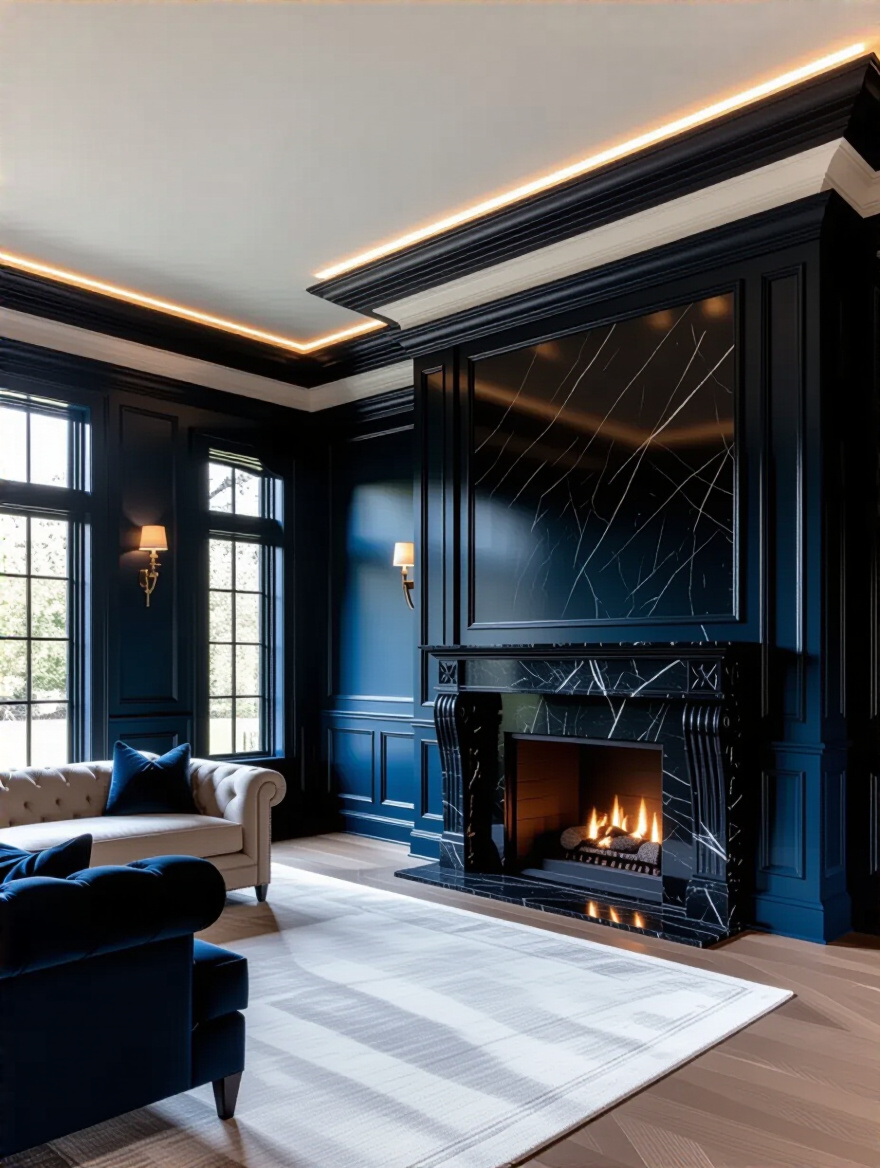
Your job as a steward of the home is to preserve these elements. If they’re damaged, have them restored by a skilled craftsperson. If they’re missing, study the home’s period and invest in historically accurate reproductions. The fireplace is the heart of the room—its mantelpiece and surround set the tone for everything else. Restore the original tile, stone, or wood. This respect for architectural integrity is the ultimate expression of luxury.
This attention to the frame of the room allows for even more artistic expression in the pieces we choose to fill it with.
The coffee table is the center of your conversational universe, and it’s a massive opportunity to add an artistic, sculptural element to the room. The BS everyone falls for is buying a matching “table set” from a big box store—a coffee table and two end tables that are all identical. It’s boring and lacks personality. Instead, think of your coffee table as a standalone piece of art that also happens to be where you put your drink.
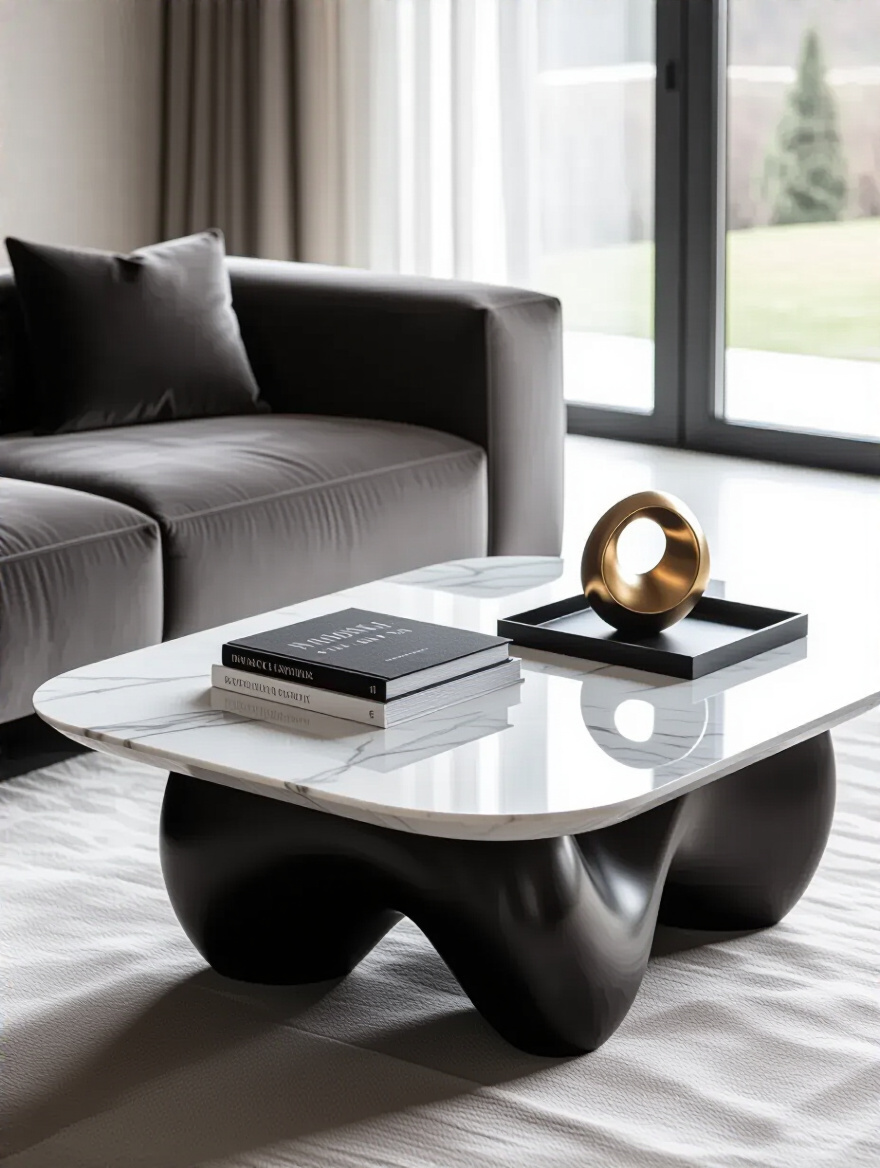
Look for interesting materials—a beautiful piece of reclaimed wood, a slab of veined marble, a metal form with a unique patina. I love using a cluster of smaller tables or even a large, upholstered ottoman instead of a single table. It’s more flexible and adds more texture. And pay attention to scale! A common mistake is a coffee table that’s too small and feels lost, or one so large it blocks all movement. It should feel proportional to your sofa and be easy to navigate around.
Now we introduce the supporting actors that bring style and personality to the main seating group.
This is where we add layers of comfort, art, and personal expression. The foundation is set, but these are the elements that make the room sing with character and feel deeply personal and inviting.
Beyond the sofa, your accent chairs are where you can really have fun and inject personality. They are the perfect place to introduce a bold color, a unique shape, or an unexpected texture. Think of them as functional sculptures. Instead of buying two matching chairs, find a pair with beautiful lines or a single, stunning armchair that can stand on its own as a design statement.
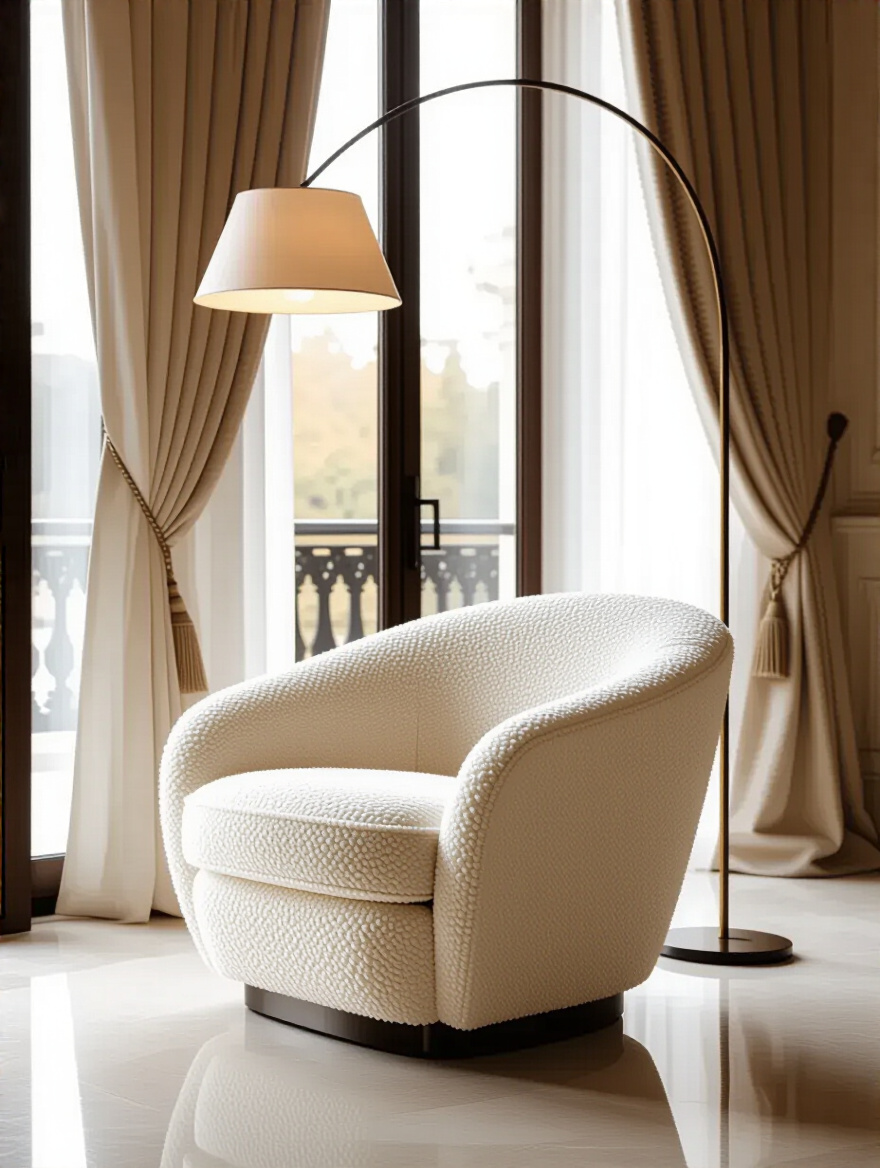
This is a place to invest in a classic designer piece, like an Eames Lounge Chair, which works beautifully in both modern and traditional settings, or to find a unique vintage frame and have it reupholstered in a spectacular fabric. A great accent chair isn’t just extra seating; it’s an exclamation point. I once used a single, beautifully carved antique bergère chair upholstered in a vibrant contemporary print in an otherwise traditional room. It became everyone’s favorite seat and the most talked-about piece in the house.
These sculptural forms become even richer when draped with luxurious, tactile fabrics.
Luxury isn’t just a look; it’s a feeling. The way a room feels to the touch is just as important as how it looks. This is where layering textiles comes in. Think of the richness of a velvet sofa, the soft sheen of silk curtains, and the unbelievable comfort of a cashmere throw blanket. These materials add incredible depth, warmth, and sophistication.
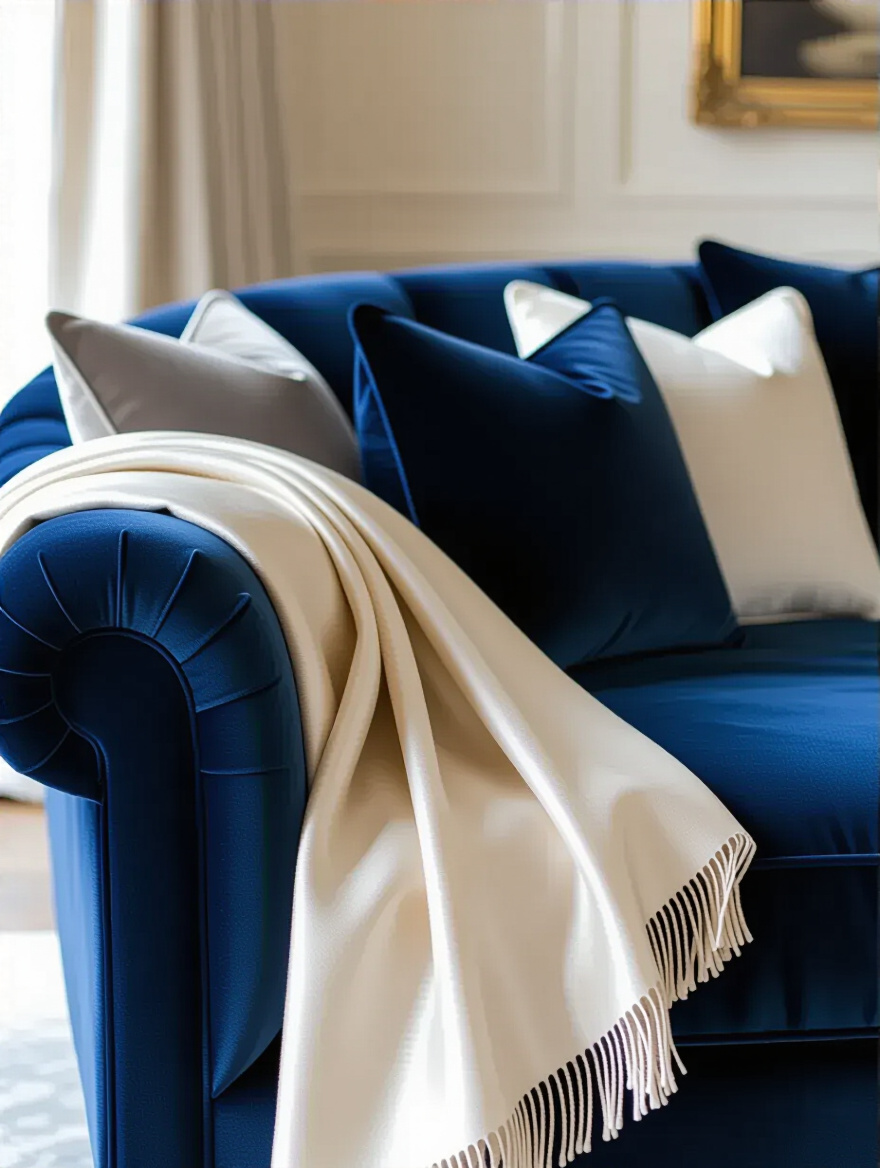
Don’t be afraid to mix them. A linen-covered sofa can be brought to life with velvet and silk pillows. A leather chair is made more inviting with a soft wool throw. I wish someone had told me early on to always get fabric samples and live with them in the room for a few days. The way a fabric looks under the store lights is completely different from how it will look in the natural light of your home. It’s a simple step that prevents very expensive mistakes.
These textiles find their most dramatic expression in the way you dress the windows.
Store-bought curtains that are too short are a design sin. I call them “high-water drapes,” and they instantly make a grand room feel cheap and unfinished. In a historic home with beautiful, tall windows, custom window treatments are a non-negotiable investment. They are the tailored suit of the room, adding softness, controlling light, and providing a final, polished layer.

For a truly luxurious feel, drapes should be made of a substantial fabric like lined velvet, silk, or heavy linen. They should be hung from a high-quality rod installed several inches above the window frame and wide enough so the panels frame the window when open, not block it. And they absolutely must kiss the floor or even “puddle” slightly for a classic, opulent look. Layering sheer curtains underneath gives you privacy and diffuses light beautifully while still allowing you to enjoy the view.
Now that the room is fully dressed, we can add the final layer of adornment that makes it uniquely yours.
This final stage is about infusing the space with your soul. Art, objects, and living things are what transform a well-designed room into a home. These are the elements that tell your story.
Your walls are not just barriers; they are canvases waiting for your story. Art is deeply personal, and it’s the most powerful way to inject your personality into a space. Don’t buy art because it matches your sofa. Buy art that moves you, that you have a connection with. Whether it’s a painting from a local artist, a piece you found on your travels, or even a beautifully framed family photograph, it should mean something to you.
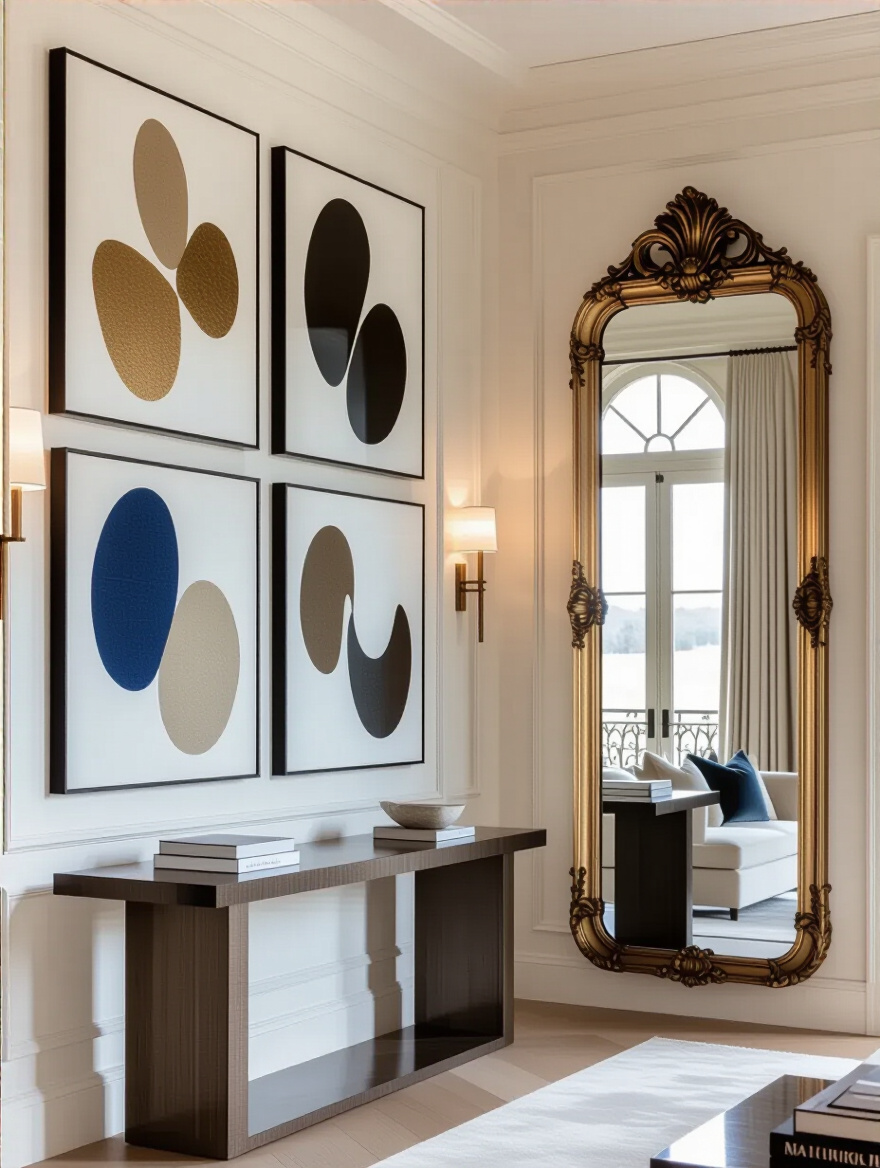
And a note on mirrors: they are miracle workers in older homes, which can sometimes feel dark. A large, beautiful mirror placed opposite a window can double the amount of light in a room and create the illusion of more space. The key is to be mindful of what it’s reflecting. Make sure it reflects something beautiful, like the view outside or a stunning piece of art on the opposite wall, not a cluttered corner.
These larger statements are supported by the smaller, carefully chosen objects you live with.
Please, step away from the aisles of mass-produced, generic “decor.” True luxury is in the unique and the well-crafted. This is about curating a collection of objects over time that have meaning and beauty. A handcrafted ceramic vase, a small bronze sculpture, a beautifully grained wooden bowl—these are the things that add soul and a sense of history.
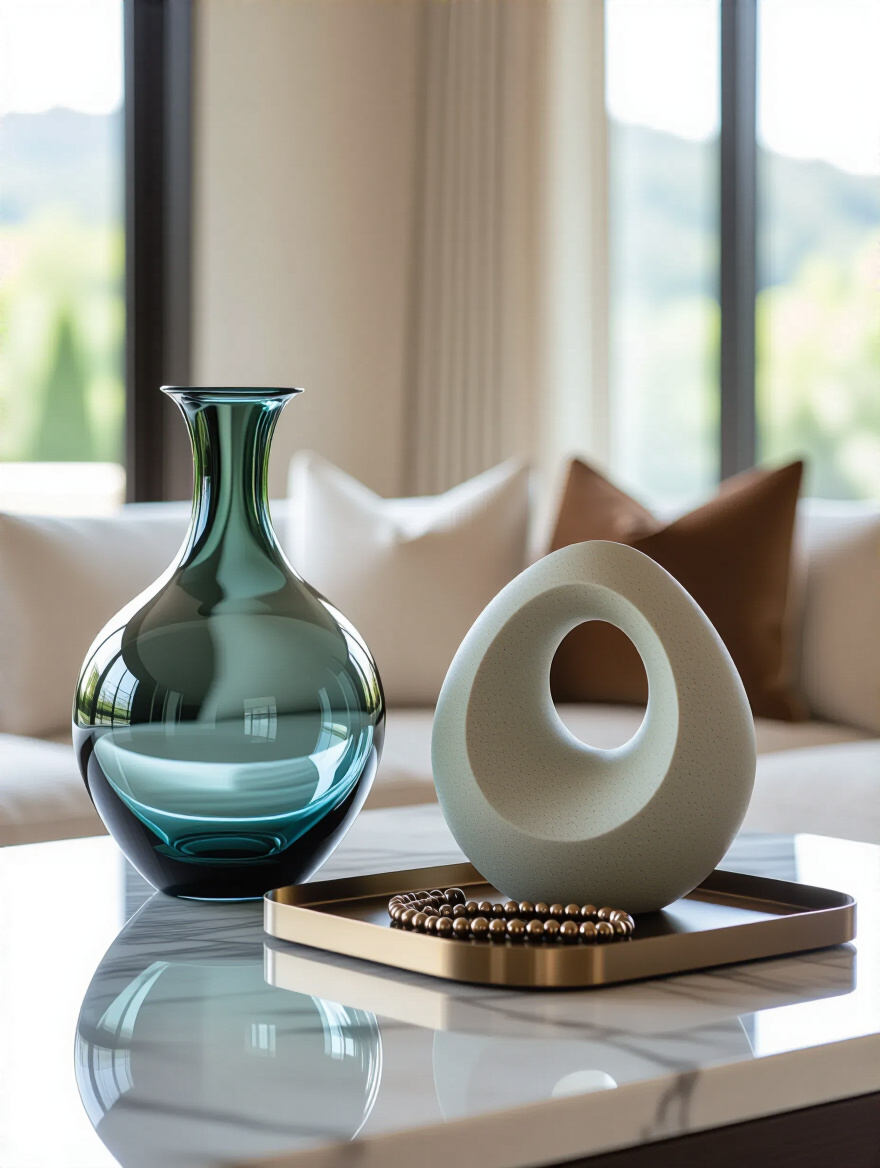
I tell my clients to follow the “one in, one out” rule to avoid clutter. The goal isn’t to fill every surface, but to create small, thoughtful arrangements—or vignettes—that draw the eye. A beautiful tray on a coffee table can corral a few precious items—a candle, a small plant, a favorite book—and make them feel intentional and curated rather than random. It’s always better to have one beautiful, meaningful object than ten cheap, soulless ones.
This idea of curation extends to the living elements you bring into the space.
Nothing brings life and energy into a room quite like plants and flowers. A tall fiddle-leaf fig in a beautiful ceramic pot can feel like a living sculpture, adding height and an organic element that softens the hard lines of architecture. Fresh flowers, even just a simple branch cut from the garden, add an ephemeral beauty and a touch of indulgence.
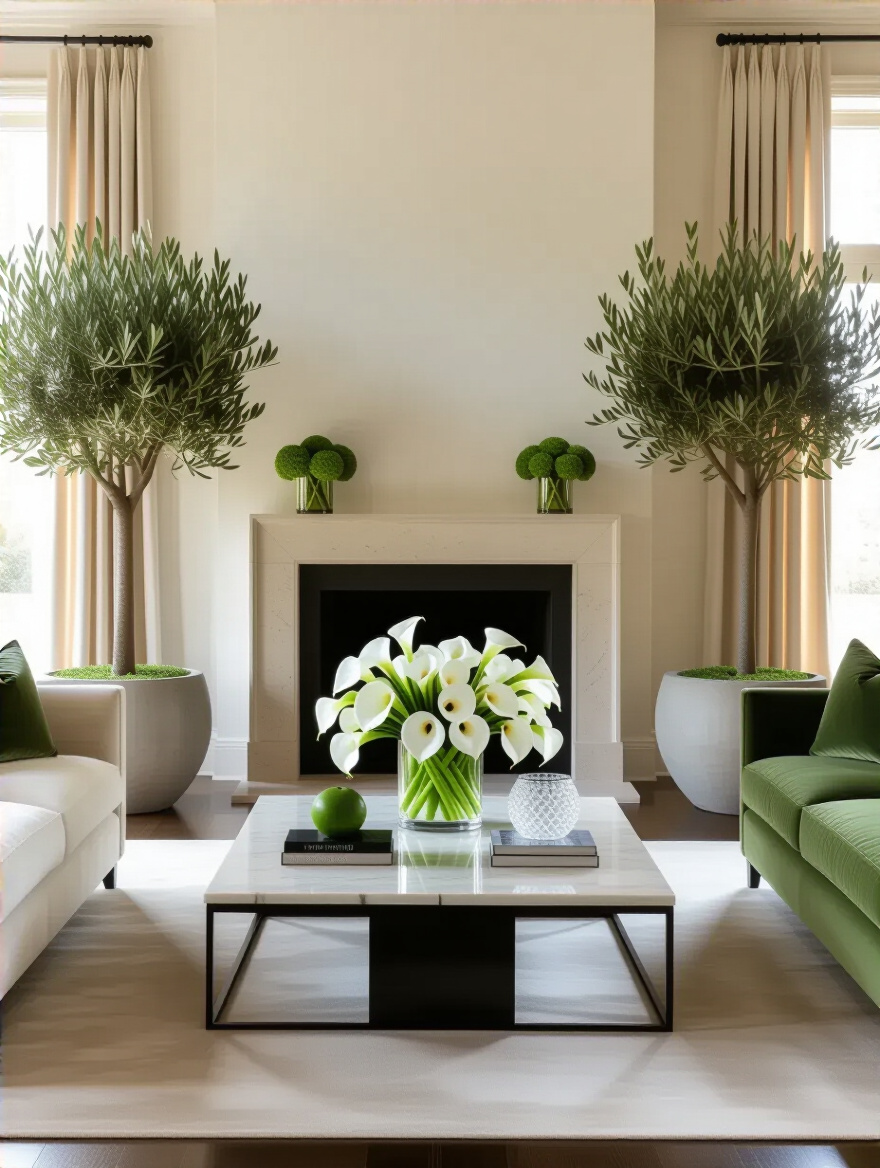
The key is to treat the vessel with as much care as the plant. Invest in beautiful, high-quality planters and vases that complement your decor. Don’t just stick a plastic nursery pot into a cheap basket. A substantial stoneware, terracotta, or ceramic planter elevates the entire look. It’s a small detail, but it makes a world of difference in creating a space that feels intentional and cared for.
This care for the living elements parallels a care for the invisible atmosphere of the room.
So much of what makes a room feel luxurious is invisible. It’s the scent that greets you when you walk in, the sound of soft music playing, the feeling of rich textures under your fingertips. This multi-sensory approach is what separates a truly magnificent space from one that just looks good in photos. It creates a complete, immersive experience.
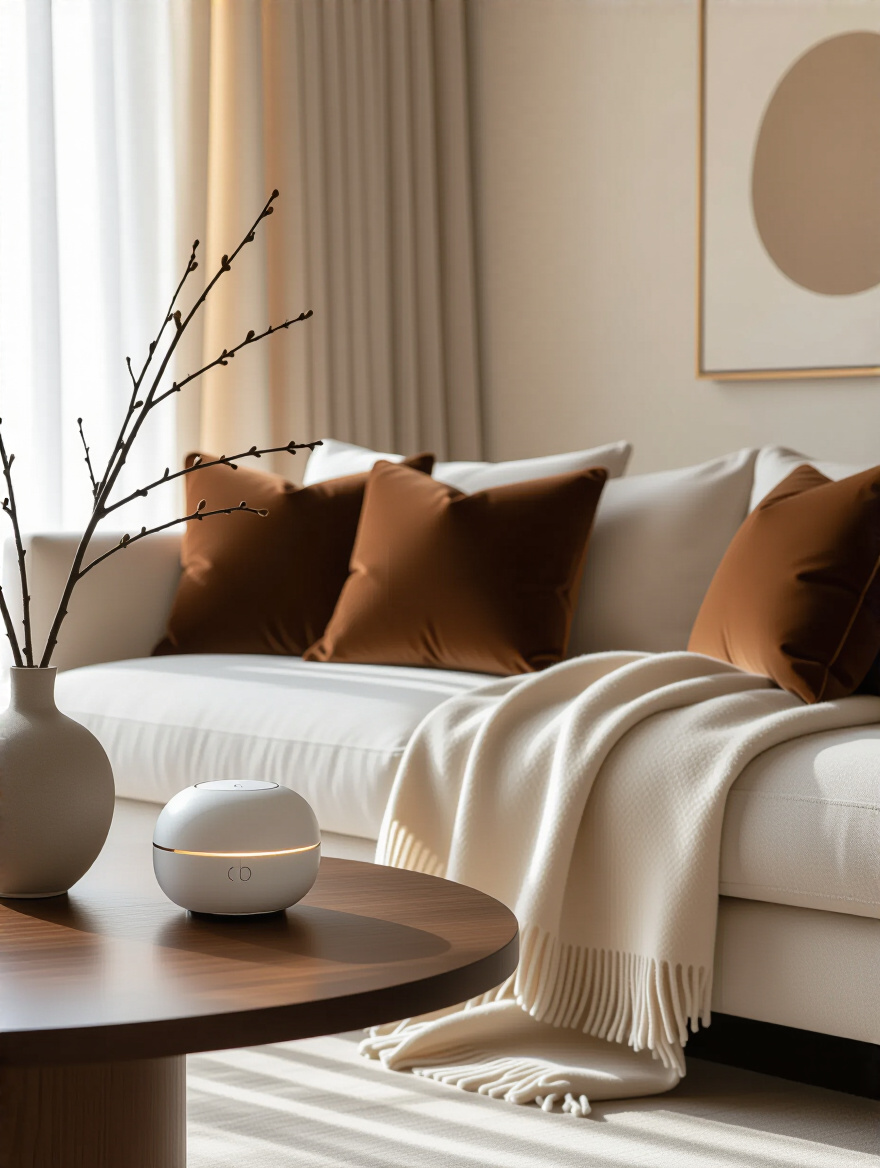
Find a signature scent for your home—something subtle, like sandalwood, cedar, or a high-quality floral—and use it consistently through candles or a diffuser. It becomes a memory trigger, a sign that you are home. And think about sound. In older homes, sound can carry. Wool rugs, drapery, and upholstered furniture are all crucial for absorbing sound and creating a quiet, peaceful atmosphere. This attention to the unseen environment is the secret weapon of truly high-end design.
Finally, we ensure that all this beauty and comfort can be enjoyed effortlessly, with a nod to modern convenience.
Luxury in the 21st century also means seamless convenience and a commitment to preserving the beauty you’ve so carefully created. This final section is about integrating modern functionality without disrupting the historic soul of your home and establishing the rituals to care for it for generations to come.
I confess: I used to think smart home tech was a gimmick that had no place in a historic home. Then a client with a stunning 1890s Queen Anne asked for it, and I realized the ultimate luxury is when technology is invisible and in service to the home’s character. It’s not about flashy screens on the walls. It’s about motorized window shades that disappear when not in use, or lighting that adjusts automatically with the setting sun, all controlled from your phone.
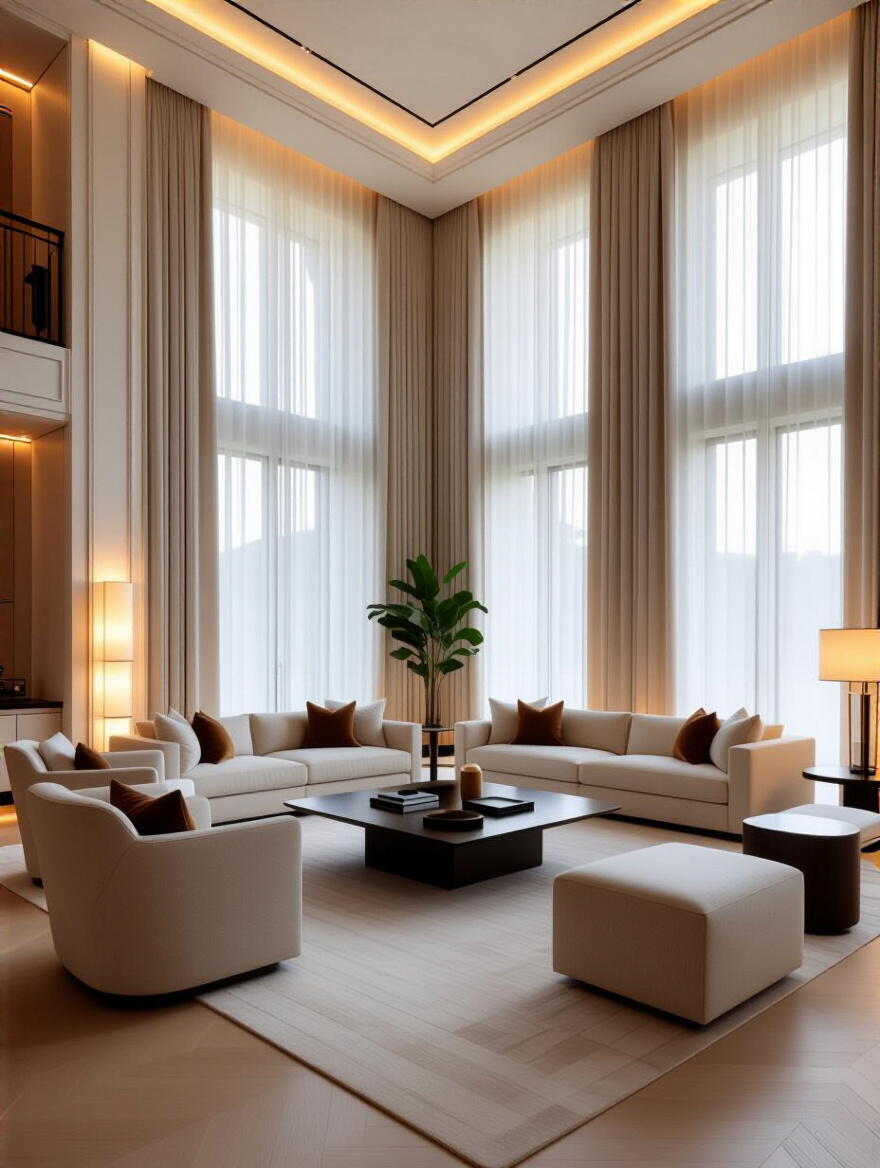
The goal is to enhance comfort without visually disrupting the architecture. Think hidden speakers that provide incredible sound without a single visible wire or grill. Smart thermostats that learn your schedule can be discreetly integrated. The shortcut I wish I’d known earlier is to plan for this from the very beginning. Working with a professional integrator to hide wiring and components during the renovation phase is key to making the technology feel completely seamless, as if it were magic.
This blend of old and new requires a dedicated approach to its upkeep.
You wouldn’t buy a vintage Rolls-Royce and then never change the oil. The same principle applies to a historic home filled with beautiful things. True luxury requires stewardship. You must have a plan to care for the fine materials you’ve invested in. This means knowing how to properly clean old wood, care for a wool rug, protect leather from drying out, and dust delicate plasterwork without causing damage.
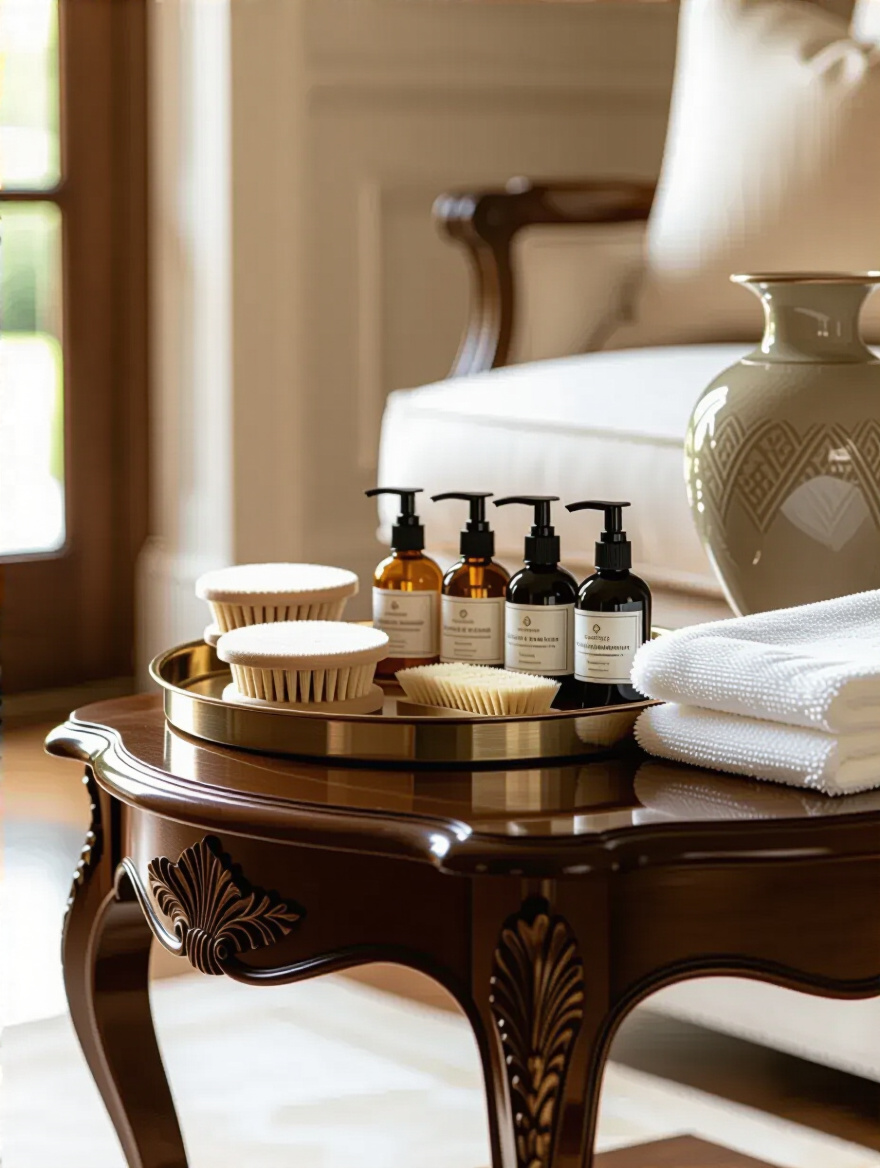
Create a simple schedule. Note which pieces need professional cleaning and how often. Use the right products—gentle, pH-neutral soaps for stone, appropriate waxes for antique wood, never harsh chemicals. This regimen isn’t a chore; it’s a ritual of respect for the craftsmanship that went into creating your home and its furnishings. It ensures that the beauty and value of your investments don’t just last, but deepen with time.
Creating a luxurious living room in a home with history isn’t about following a formula or buying expensive things. It’s about becoming a detective, a storyteller, and a devoted steward. It’s a process of listening to the whispers of the past while making the space sing with your own voice. Each of these principles is a guide to help you create a room that is not only beautiful and comfortable but also rich with soul and authenticity.
Don’t let the dream of such a space remain a vision. Start with one thing. Maybe it’s finding the perfect, oversized rug to anchor your room, or finally investing in the custom drapes those tall, elegant windows deserve. Your dream luxurious living room is an achievable reality. By honoring the past and thoughtfully curating the present, you aren’t just decorating a room—you are contributing to the ongoing story of a home, creating a personal haven that will bring you joy and inspiration for years to come.